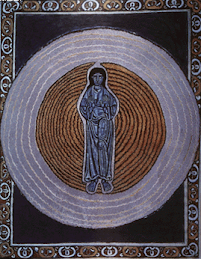
I was invited to make a presentation at a Miqra event put together by the youth leaders of the Diocese of Chicago. I've posted a slightly expanded version in installments. Here's the whole thing with links:
Introduction
Reading scripture, according to the great 2nd century theologian Irenaeus of Lyons, is like configuring a mosaic of precious jewels. That mosaic can be configured in more ways than one. According to Irenaeus, it can be configured to reveal a portrait of the King – Jesus Christ as the Church knows him – or it can be configured, as it was by heretics and other false teachers, as something else, say a fox. More
Part 2: Among other things, honoring the scriptures means we must attend to the kinds of texts they are rather than impose theories of what we think they should be if they are inspired and authoritative. More
Part 3: Can we identify some guidelines or criteria by which we evaluate more faithful biblical configurations from less faithful or even faithless interpretations? Not all configurations are faithful. Not all faithful configurations are equally faithful. But there might be a range of recognizably, more or less, faithful configurations. The following criteria, based on how the canon of scripture came to be accepted and how the early Church read the Bible, are suggested to assist in configuring the mosaic of scripture. More
1. The Criterion of Jesus Christ
2. The Criterion of Love
3. The Criterion of the Rule of Faith
4. The Criterion of the Church's Prayer
5. The Criterion of the Church's Tradition
6. The Criterion of Comprehensiveness
7. The Criterion of Dissimilarity
8. The Criterion of Community
9. The Criterion of Character
No one criterion is adequate and no set of criteria will assure agreement on particular questions of interpretation. But, an interplay of the above criteria would provide a broad measure of relative faithfulness as we seek to configure an image of the King rather than a fox or a dog.
These are criteria that make sense to me. What might be some I am missing?





5 comments:
This is great stuff! I'll ponder this a bit, then respond at my blog. My gut instinct, though, is that your first criterion is too narrow... I think we have to appeal to the character of God--Triune but most clearly revealed to us through the God-Man Jesus. After all, defending the character of God is the whole point of Romans 9-11.
[Had to delete my first comment due to serious grammar-fail!]
Thanks, Derek,
"but most clearly revealed to us through the God-Man Jesus"
That's the point of the first criterion. But, it does not stand alone, hence the other eight. Criteria 3, 4, & 5 in particular bring us into the fuller account of the characer of God.
I did wonder about another criterion focused on the continuity of the God revealed to Israel and the God revealed through Jesus and thus God's faithfulness to all God has promised.
Father Matt...came back here again because of your comments on my blog post about "inerrancy" last year. I like a lot of what you share here.
I also like that you're a Glass Harp fan.
I'm guessing that if we poked around our histories that we would have a lot in common.
Peace!
Thanks, Joey. I'm glad you like this. I haven't read it for a while and am wondering where i might revise it two and a half years on.
I got into Glass Harp while in college in the late 70's. I was already listening to Phil Keaggy. I have their CD's and still listen every now and then.
I actually saw Keaggy in concert a couple of years ago and he played 'Can You See me Brother'- to my great delight.
Post a Comment